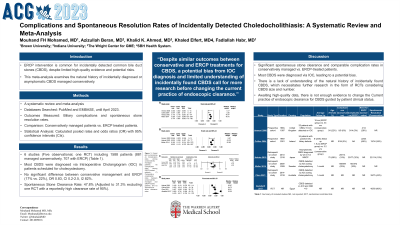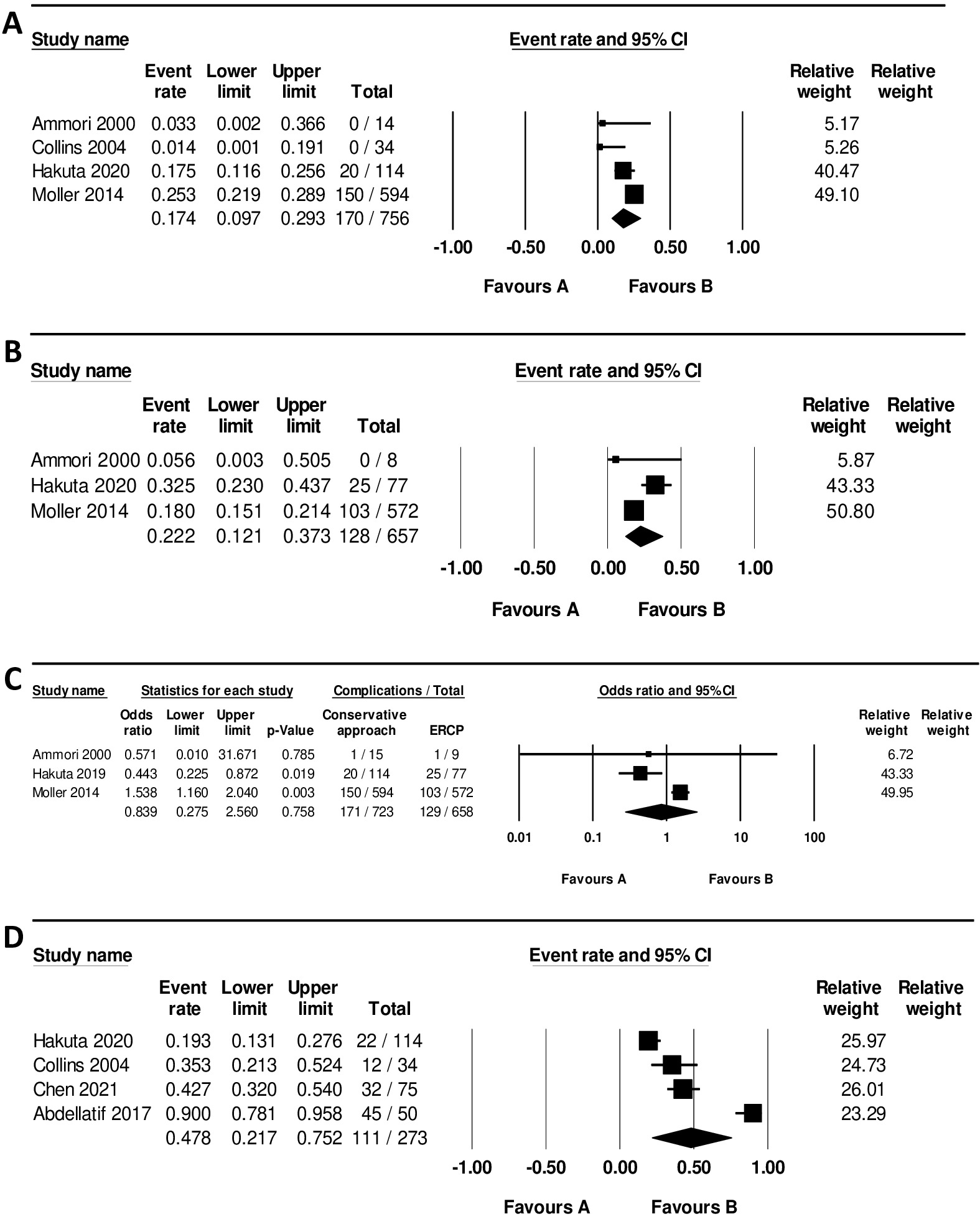Monday Poster Session
Category: Biliary/Pancreas
P1453 - Complications and Spontaneous Resolution Rates of Incidentally Detected Choledocholithiasis: A Systematic Review and Meta-Analysis
Monday, October 23, 2023
10:30 AM - 4:15 PM PT
Location: Exhibit Hall

Has Audio

Mouhand FH Mohamed, MD
Brown University
Providence, RI
Presenting Author(s)
Mouhand FH. Mohamed, MD1, Azizullah Beran, MD2, Khalid K. Ahmed, MD3, Khaled Elfert, MD4, Fadlallah Habr, MD5
1Brown University, Providence, RI; 2Indiana University, Indianapolis, IN; 3The Wright Center for GME, Scranton, PA; 4SBH Health System, Bronx, NY; 5Brown University/Lifespan Physician Group, East Providence, RI
Introduction: The incidental detection of common bile duct stones (CBDS) often triggers Endoscopic retrograde cholangiopancreatography (ERCP) intervention despite the limited high-quality evidence supporting its efficacy and the potential risks involved. This systematic review and meta-analysis aim to examine the natural history of incidentally diagnosed or asymptomatic CBDS managed conservatively.
Methods: We searched PubMed and EMBASE databases from their inception through April 2023 for studies assessing the natural history of conservatively managed CBDS. The biliary complications and spontaneous stone resolution rates were considered primary and secondary outcomes, respectively. We compared complication rates between conservatively managed (wait-and-see approach) patients and those treated with ERCP. Pooled rates and odds ratios (OR) with corresponding 95% confidence intervals (CIs) were calculated.
Results: Our analysis included six studies (five observational, one RCT). In five studies, incidental or asymptomatic CBDS were discovered via Intraoperative Cholangiogram (IOC) in patients scheduled for cholecystectomy. Due to the absence of symptoms and complications, not all underwent ERCP. We analyzed data from 1588 CBDS patients (881 managed conservatively, 707 with ERCP) (Table 1). Complication rates showed no significant difference between conservative management and ERCP approaches (17% vs. 22%; OR 0.83, CI 0.2-2.5, I2 82%) (Figure 1 A-C). The spontaneous stone clearance rate was 47.8% (CI 22%-75%, I2 93%) (Figure 1 D). Excluding the only RCT with a notably high clearance rate of 90%, the adjusted clearance rate was 31.3% (95% CI 18-49%, I2 83%).
Discussion: This meta-analysis revealed significant spontaneous stone clearance and comparable complication rates of CBDS in conservatively managed patients compared to those undergoing ERCP for asymptomatic, incidentally detected CBDS. However, most CBDS were diagnosed via IOC, introducing potential bias as those stones may not have been entirely incidental and could have been symptomatic leading to the cholecystectomy. Our results highlight a clinical gap in understanding the natural history of incidentally found CBDS, necessitating further research, particularly randomized trials taking into consideration the size and number of the CBDS when comparing the “wait and see” to ERCP approaches. At this juncture, due to the lack of high-quality studies, the approach to incidental CBDS remains endoscopic clearance guided by the patient clinical status.

Disclosures:
Mouhand FH. Mohamed, MD1, Azizullah Beran, MD2, Khalid K. Ahmed, MD3, Khaled Elfert, MD4, Fadlallah Habr, MD5. P1453 - Complications and Spontaneous Resolution Rates of Incidentally Detected Choledocholithiasis: A Systematic Review and Meta-Analysis, ACG 2023 Annual Scientific Meeting Abstracts. Vancouver, BC, Canada: American College of Gastroenterology.
1Brown University, Providence, RI; 2Indiana University, Indianapolis, IN; 3The Wright Center for GME, Scranton, PA; 4SBH Health System, Bronx, NY; 5Brown University/Lifespan Physician Group, East Providence, RI
Introduction: The incidental detection of common bile duct stones (CBDS) often triggers Endoscopic retrograde cholangiopancreatography (ERCP) intervention despite the limited high-quality evidence supporting its efficacy and the potential risks involved. This systematic review and meta-analysis aim to examine the natural history of incidentally diagnosed or asymptomatic CBDS managed conservatively.
Methods: We searched PubMed and EMBASE databases from their inception through April 2023 for studies assessing the natural history of conservatively managed CBDS. The biliary complications and spontaneous stone resolution rates were considered primary and secondary outcomes, respectively. We compared complication rates between conservatively managed (wait-and-see approach) patients and those treated with ERCP. Pooled rates and odds ratios (OR) with corresponding 95% confidence intervals (CIs) were calculated.
Results: Our analysis included six studies (five observational, one RCT). In five studies, incidental or asymptomatic CBDS were discovered via Intraoperative Cholangiogram (IOC) in patients scheduled for cholecystectomy. Due to the absence of symptoms and complications, not all underwent ERCP. We analyzed data from 1588 CBDS patients (881 managed conservatively, 707 with ERCP) (Table 1). Complication rates showed no significant difference between conservative management and ERCP approaches (17% vs. 22%; OR 0.83, CI 0.2-2.5, I2 82%) (Figure 1 A-C). The spontaneous stone clearance rate was 47.8% (CI 22%-75%, I2 93%) (Figure 1 D). Excluding the only RCT with a notably high clearance rate of 90%, the adjusted clearance rate was 31.3% (95% CI 18-49%, I2 83%).
Discussion: This meta-analysis revealed significant spontaneous stone clearance and comparable complication rates of CBDS in conservatively managed patients compared to those undergoing ERCP for asymptomatic, incidentally detected CBDS. However, most CBDS were diagnosed via IOC, introducing potential bias as those stones may not have been entirely incidental and could have been symptomatic leading to the cholecystectomy. Our results highlight a clinical gap in understanding the natural history of incidentally found CBDS, necessitating further research, particularly randomized trials taking into consideration the size and number of the CBDS when comparing the “wait and see” to ERCP approaches. At this juncture, due to the lack of high-quality studies, the approach to incidental CBDS remains endoscopic clearance guided by the patient clinical status.

Figure: Figure 1: Forest plot summarizing A) Complication rates among conservatively managed patients, B) Complication rates among ERCP-treated patients., C) Comparative complication rates between conservatively managed and ERCP-treated patients, and D) Spontaneous stone clearance rates.
Disclosures:
Mouhand Mohamed indicated no relevant financial relationships.
Azizullah Beran indicated no relevant financial relationships.
Khalid Ahmed indicated no relevant financial relationships.
Khaled Elfert indicated no relevant financial relationships.
Fadlallah Habr indicated no relevant financial relationships.
Mouhand FH. Mohamed, MD1, Azizullah Beran, MD2, Khalid K. Ahmed, MD3, Khaled Elfert, MD4, Fadlallah Habr, MD5. P1453 - Complications and Spontaneous Resolution Rates of Incidentally Detected Choledocholithiasis: A Systematic Review and Meta-Analysis, ACG 2023 Annual Scientific Meeting Abstracts. Vancouver, BC, Canada: American College of Gastroenterology.
